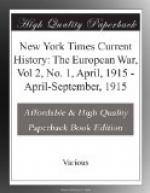These supports held up the enemy, who, however, managed to establish himself in the brick stacks and some communication trenches between the keep, the road, and the canal—and even beyond the west of the keep on either side of it.
The London Scottish had in the meantime been sent up in support, and a counter-attack was organized with the First Royal Highlanders, part of the First Cameron Highlanders, and the Second King’s Royal Rifle Corps, the latter regiment having been sent forward from the Divisional Reserve.
The counter-attack was delayed in order to synchronize with a counter-attack north of the canal which was arranged for 1 P.M.
At 1 P.M. these troops moved forward, their flanks making good progress near the road and the canal, but their centre being held up. The Second Royal Sussex Regiment was then sent forward, late in the afternoon, to reinforce. The result was that the Germans were driven back far enough to enable a somewhat broken line to be taken up, running from the culvert on the railway, almost due south to the keep, and thence southeast to the main road.
The French left near the road had also been attacked and driven back a little, but not to so great an extent as the British right. Consequently the French left was in advance of the British right, and exposed to a possible flank attack from the north.
The Germans did not, however, persevere further in their attack.
The above-mentioned line was strengthened during the night, and the First Guards Brigade, which had suffered severely, was withdrawn into reserve and replaced by the Second Infantry Brigade.
While this was taking place another and equally severe attack was delivered north of the canal against the village of Givenchy.
At 8:15 A.M., after a heavy artillery bombardment with high explosive shells, the enemy’s infantry advanced under the effective fire of our artillery, which, however, was hampered by the constant interruption of telephonic communication between the observers and batteries. Nevertheless, our artillery fire, combined with that of the infantry in the fire trenches, had the effect of driving the enemy from its original direction of advance, with the result that his troops crowded together on the northeast corner of the village and broke through into the centre of the village as far as the keep, which had been previously put in a state of defense.
[Illustration: The places underlined in the above map indicate the points around La Bassee and southward to Arras, where part of the British Expeditionary Force was heavily engaged.]
The Germans had lost heavily, and a well-timed local counter-attack, delivered by the reserves of the Second Welsh Regiment and First South Wales Borderers, and by a company of the First Royal Highlanders, (lent by the First Brigade as a working party—this company was at work on the keep at the time,) was completely successful, with the result that after about an hour’s street fighting all who had broken into the village were either captured or killed, and the original line around the village was re-established by noon.




